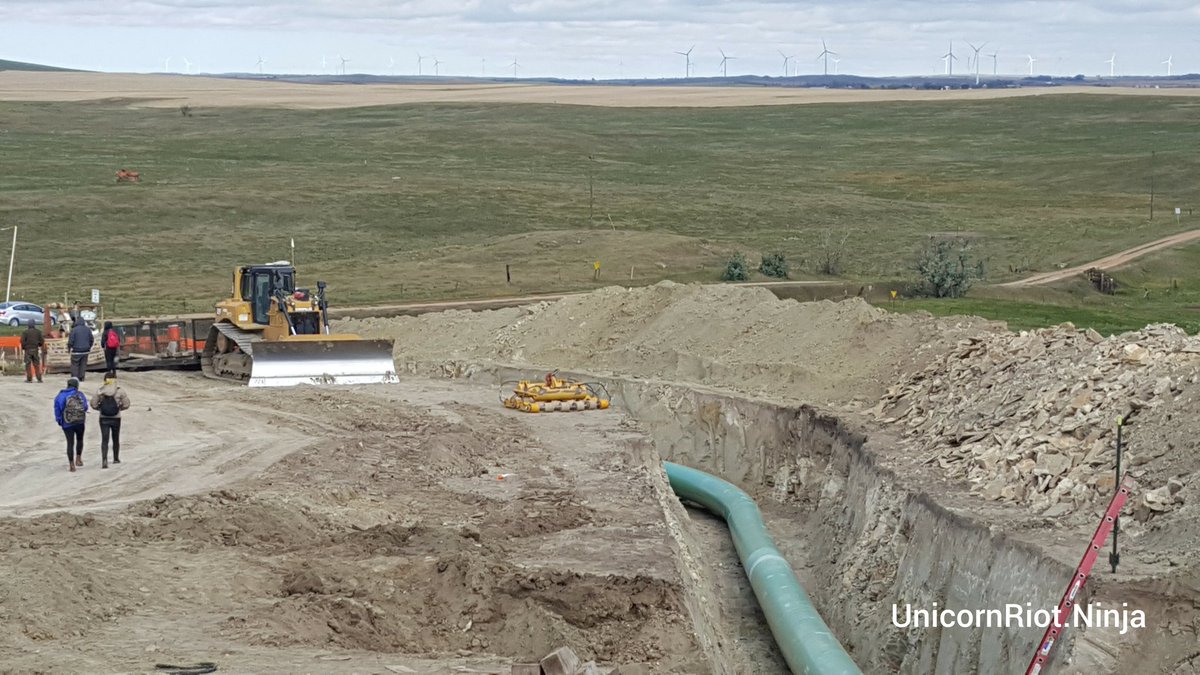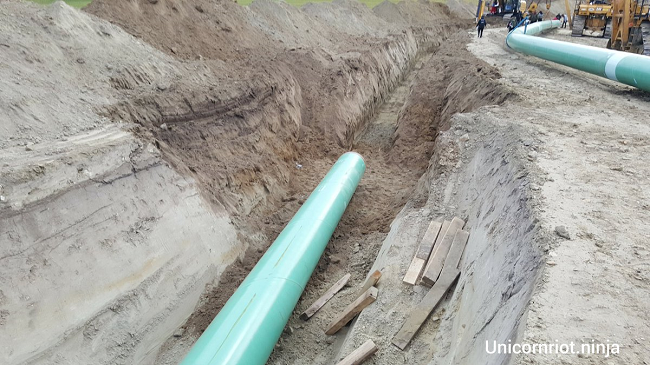Dakota Access Pipeline Spills at South Dakota Pump Station
UPDATE (May 22, 2017): Since the initial news of its April 4 spill in South Dakota, reports have emerged that the Dakota Access Pipeline spilled twice in North Dakota on March 3 and March 5 of this year. The AP reports:
Bismarck, N.D. – (AP) — The Dakota Access pipeline system leaked more than 100 gallons of oil in two separate incidents in North Dakota in March as crews prepared the pipeline for operation.
They’re the $3.8 billion pipeline’s second and third known leaks.
A state Health Department database shows 84 gallons spilled at a pipeline terminal in Watford City on March 3. An agency of the federal Department of Transportation reports that 20 gallons leaked March 5 at an above-ground station in rural Mercer County. Both spills have been cleaned up.
The pipeline also leaked 84 gallons of oil at a rural pump station in South Dakota on April 4.
Pipeline opponents say leaks bolster their demands for further environmental review of the pipeline.
Developer Energy Transfer Partners says the North Dakota-to-Illinois pipeline is safe.
Spink County, SD – Officials have provided public notice of a leak of oil from the Dakota Access Pipeline (DAPL) which occurred over a month ago. On April 4, 84 gallons of oil (roughly equivalent to two barrels) leaked at a pipeline pump station in a rural area near Crandon, South Dakota, according to the state’s Department of Environment and Natural Resources Ground Water Quality Program. The Dakota Access Pipeline is not yet operational but company officials claim it will go online June 1.
The Dakota Access Pipeline faced massive opposition in North Dakota, where it’s route goes underneath the Missouri River about a mile upstream from the Standing Rock Sioux Tribe reservation. Indigenous water protectors have repeatedly cited the threat to clean drinking water posed by a potential pipeline leak as well as a lack of consent from affected tribes, among their motivations for fighting the pipeline.
“These spills are going to be nonstop,” Standing Rock tribal Chairman Dave Archambault told ABC news. “With 1,200 miles of pipeline, spills are going to happen. Nobody listened to us. Nobody wants to listen, because they’re driven by money and greed.”
- Click here to support Unicorn Riot in producing our full-length feature documentary about the resistance to the Dakota Access Pipeline, “Black Snake Killaz: A #NoDAPL Story”
The Standing Rock Sioux Tribe released an official statement responding to the leak shortly after the news broke on Wednesday:
“The Dakota Access pipeline has not yet started shipping the proposed half million barrels of oil per day and we are already seeing confirmed reports of oil spills from the pipeline. This is what we have said all along: oil pipelines leak and spill. Our lawsuit challenging this dangerous project is ongoing and it’s more important than ever for the court to step in and halt additional accidents before they happen – not just for the Standing Rock Sioux Tribe and our resources but for the 17 million people whose drinking water is at risk.” –Standing Rock Sioux Tribe

Dakota Access confirmed the leak in statements to Dakota Media Group:
Vicki Granado, spokeswoman for the Texas-based developer Energy Transfer Partners, said the spill was due to a malfunction during the line fill process.
“Before a line goes into service you have to fill it with crude oil first,” she said.
Pipeline operator Energy Transfer Partners, claims the spill was entirely cleaned up and contained within the pump station area. Some oil-soaked gravel was disposed of in the nearby Brown County Landfill. State officials said no fines will be issued as a result of the leak.
Brian Walsh of the Department of Natural Resources and Environment’s Ground Water Quality Program downplayed the significance of the spill and defended his agency’s delay in notifying the public in a statement given to ABC News:
“We realize Dakota Access gets a lot of attention. We also try to treat all of our spills in a consistent manner … We treated this as we would treat any other 84-gallon oil spill … At the pipeline’s pump station there’s what’s called a surge tank, which is used to store crude oil occasionally during the regular operation of the pipeline … And connected to that tank is a pump, which pumps oil back into the pipeline system, and the leak occurred at that surge pump.”
According to pipeline safety expert Richard B. Kuprewicz, the spill, while small in size, does not exactly bode well for DAPL.
“The releases in the pump station are better than having it on the main line. It sounds like it occurred during the process of commissioning the line … As far as this happening during the start-up, I don’t want to make it sound like a major event, but the fact that you had oil leaving the tank says there’s something not right with their procedures. They might have been trying to hurry … It shouldn’t happen, but if it did happen, at least it happened in the pump station. They need to figure out why this happened” – Richard B. Kuprewicz, quoted in Watertown Public Opinion, “S.D. looking into Dakota Access oil pipeline leak in Spink County”
The April 4 DAPL spill in rural South Dakota is part of a series of accidents involving pipelines operated by Energy Transfer Partners. On May 10th, the day of this writing, officials in Ohio fined Energy Transfer Partners $430,000 for health and safety violations after they spilled two million gallons of drilling fluid in a ‘pristine’ wetlands area while conducting drilling for the Rover natural gas pipeline in March.
“State officials say work on the Rover natural gas pipeline since March has resulted in 18 incidents involving mud spills from drilling, stormwater pollution and open burning. One spill affected a village’s public water system. Another accident released millions of gallons of bentonite mud, a drilling lubricant, into a protected wetland area.
Haphazard conditions continued this week when 200 gallons of mud were released in a Harrison County spill Monday.” – Ohio Morning Journal News, “Pipeline builder fined over water, air violations”
In September 2016, an analysis of federal data by the Center for Biological Diversity found that
Energy Transfer Partners, the conglomerate behind the controversial Dakota Access oil pipeline, is responsible for 29 pipeline safety incidents since 2006, in which 9,555 barrels of hazardous liquids were leaked … Those spills resulted in $9.5 million in property damage … “
Energy Transfer Partners has recently refused to publicly release information regarding the status of the Dakota Access Pipeline, citing “coordinated physical attacks” as justification for secrecy. (See our March 2017 report on sabotage actions against DAPL and other pipeline projects.) The pipeline company has also withheld certain safety information, such as plans to respond to oil spills, under the same grounds.
On April 24, the Army Corps of Engineers rejected a Freedom of Information Act (FOIA) request for DAPL oil spill assessment reports on the grounds that releasing them would “endanger peoples lives and property.”
Please consider a tax-deductible donation to help sustain our horizontally-organized, non-profit media organization:

Watch our feature-length documentary, Black Snake Killaz: A #NoDAPL Story
March - May 2016- March 29th, “Tribal Citizens Prepare to Blockade Bakken Oil Pipeline“.
- April 3rd, “Tribal Citizens Build Camp in Path of Oil Pipeline“.
- May 5th, “Sacred Stone Camp Resists Dakota Access Pipeline“.
- May 27th, “Dakota Access Pipeline Blockade Enters 2nd Month“.
- After covering the camp in the spring of 2016, Unicorn Riot returned to Standing Rock Reservation on Wednesday, August 10th, when Standing Rock tribal members and allies blocked the entrance to the Dakota Access Pipeline construction site.
- On Thursday, August 11th, a dozen or so people were arrested blocking the construction site entrances.
- Day 3, Friday, the fight to protect land & water intensified around the construction sites of the Dakota Access Pipeline.
- On the 4th day, the pipeline resistance encampment swelled and prepared for more action.
- Monday, August 15th, land defenders stormed the construction site halting construction, and the next day construction was halted as well.
- August 17th saw State Police begin checkpoints, roadblocks, and psyops as protesters united to defend water.
- August 24th, camps prepared as Federal injunction hearing looms.
- Camps Organize to Stay as Injunction Postponed.
- On August 31st, Non-Violent Direct Action Stopped DAPL Construction for Over 6 Hours.
- September 6, indigenous water protectors swarmed Dakota Access Pipeline site, stopped work
- September 7, Uŋpa Nuŋpa was interviewed about ongoing #noDAPL actions
- North Dakota highway patrol refused to release email correspondence with Energy Transfer Partners
- September 8, ND National Guard took over Dakota Access Pipeline checkpoints
- Friday, September 9, US Govt. overruled federal judge and requested pipeline construction halted at Lake Oahe
- Meanwhile, cultural activities continued at #NoDAPL camps despite more arrests/warrants
- September 13, 20 were arrested during #NoDAPL lockdown, including 2 Unicorn Riot journalists
- September 14, direct actions continued against Dakota Access Pipeline while legal repression intensified
- On September 16 a federal judge dissolved the unconstitutional temporary restraining order Dakota Access, LLC had filed against Stranding Rock tribal members
- September 19, as solidarity protests spread nationwide, the federal appeals court ordered construction temporarily stop on Dakota Access segment as Solidarity Protests Spread Nationwide
- September 21, #NoDAPL noise demo demanded freedom for jailed water protector Olowan Martinez
- September 22, water protectors disrupted the annual meeting of the North Dakota Petroleum Council
- September 25, water protectors planted trees on DAPL construction site
- In Iowa on September 26, a non-violent direct action from the Mississippi Stand camp stopped DAPL construction for the day
- September 26, a caravan of water protectors stopped work at DAPL site
- September 27, militarized police arrested 23 water protectors in DAPL work stoppage
- September 29, a #NoDAPL solidarity action took place at MN Enbridge office
- October 3rd-4th saw the "Toxic Tour," Governor debate disruption, and water protectors attend their court arraignment
- October 4, we learned North Dakota Governor Dalrymple's email inbox was full of support for #NoDAPL
- October 5, Buffer Zone Holds as Caravans Continue to Disrupt DAPL – New Felony Charges
- October 7, 6 Arrested in Iowa #NoDAPL Action, Including Unicorn Riot Journalist
- October 8, Iowa Water Protectors Blockade DAPL Drill Site Twice in 24 Hours
- October 9, Federal Appeals Court Rules to Allow DAPL Construction
- October 10, 27 Arrests After Water Protectors Pray at DAPL Site on Indigenous People's Day
- October 12, Lockdown Stops DAPL Construction in Iowa, 3 Arrested, Including Unicorn Riot Journalist
- October 14, Emails Show North Dakota Budget Bureaucracy Behind #NoDAPL Policing
- October 16, Direct Actions Continue to Stop DAPL Construction in Iowa and North Dakota
- October 17, Four Unicorn Riot Journalists Face Charges For Covering #NoDAPL
- October 17, Water Protectors Blockade Highway in Bismarck, Some Charges Dropped
- October 20, As DAPL Construction Advances, Water Protectors Continue Direct Action
- October 22, Water Protectors’ Prayer Walk Ends up with 127 Arrests, Including Unicorn Riot Journalist
- October 23, Law Enforcement Attack Private Drone as Water Protectors Erect Blockade & New Winter Camp
- October 24, Mississippi Stand Blockades Iowa DAPL Drill Waste Site, Drilling Stops
- October 25, Records Release: Morton County’s Law Enforcement Mutual Aid Assistance Agreement
- Hundreds Flood Minneapolis City Hall to Demand Local Sheriff Withdraw from North Dakota
- October 26, Tensions Rise as Pipeline Construction Nears #NoDAPL Blockade
- October 27, Police and Military Attack Oceti Sakowin Treaty Camp
- November 1, #NoDAPL Solidarity Rally & Sit-In in Minneapolis Prods Sheriff into Removing Deputies
- November 1, DAPL Resistance Continues Despite Advancing Construction
- November 2, Police Attack Water Protectors Defending Sacred Sites
- November 5, DAPL Construction Nears US Army Corps Land While Still Lacking Permits
- November 6, Water Protectors Attempt to Reclaim Sacred Burial Site, Demonstrate in Cemetery
- November 8, Dakota Access Announces Plan to Drill Under Missouri River Within Weeks
- November 11, Dakota Access Pipeline Work Stopped As Water Protectors Storm Site; 30+ Arrested
- November 14, #NoDAPL Water Protectors March on ND State Capitol after Caravan Disrupts Construction
- November 14, Mississippi Stand Goes Inside Pipeline and Shuts Down DAPL Construction
- November 14, Army Corps Delays DAPL Easement
- November 15, "No More Stolen Sisters" Demonstration Blockades DAPL Man Camp; 25+ Arrests
- November 16, Despite Army Corps Statement, DAPL Moves Horizontal Drill to Missouri River Crossing
- November 17, Demonstration in Bismarck-Mandan, Cass County Deputies Beat Man Bloody
- November 20, Police Attack Unarmed Water Protectors w/ Rubber Bullets, Tear Gas, and Water Cannons; 300+ injured
- November 21, Land Defense & Water Protection Actions Ripple Across Turtle Island
- November 22, Hundreds Target U.S. Army Corps Building in St. Paul w #NoDAPL Message
- November 22, Anonymous DDOS Munitions Vendor After Sheriffs Attack #NoDAPL
- November 22, #NoDAPL Water Protector Faces Possible Loss Of Her Arm After Police Attack
- November 24, Water Protectors Bridge onto Turtle Island; Mandan Thanksgiving Street Feast
- November 25, U.S. Army Corps of Engineers Announces Intent to Close Oceti Sakowin #NoDAPL Camp
- November 29, Excessive Force Lawsuit Filed Against Morton County Sheriff for November 20 Bridge Assault
- December 1, Direct Action Continues To Disrupt Dakota Access Pipeline Construction in Iowa
- December 3, Divest from DAPL; Three Wells Fargo Locations Targeted in Minneapolis, Eight People Locked Down and Two Arrested
- December 4, Army Corps Denies Dakota Access Pipeline Easement
- December 8, Veterans Apologize for Genocide & March to Backwater Bridge in Blizzard
- December 8, Nebraska Supplied State Troopers, Surveillance Aircraft to North Dakota Under EMAC
- December 12, #DivestFromDAPL Action Disrupts Wells Fargo Branch Grand Opening, Doors Secured with Bike Locks
- December 19, First Water Protector Trials Set for January as Another ND Pipeline Leaks
- January 2, Massive #DivestFromDAPL Banner Unfurled During Vikings Game at US Bank Stadium
- January 5, Interview: Water Protector who Scaled Vikings Stadium to Drop “US Bank DIVEST #NoDAPL” Banner
- January 15, Indigenous-Led Pipeline Resistance Camps Spread Across the USA
- January 24, Hundreds of Minnesotans Protest, Take to the Streets on Trump’s Inauguration
- January 25, Trump Pushes Forward DAPL & KXL Pipeline Approvals; Resistance Continues
- January 30, Denver Joins Global Prayer Action to #DefundDAPL
- February 7, Army Corps Grants Easement as Repression Continues at Standing Rock
- February 17, Eviction Threats Loom as Hundreds Remain at #NoDAPL Camps
- February 22, Militarized Force Executes Eviction of Main #NoDAPL Encampment
- February 23, North Dakota Dismantles #NoDAPL Oceti Camp
- February 27, Three Unicorn Riot Journalists Face Trial This Week From DAPL Coverage
- March 2, Three Unicorn Riot Journalists Have #NoDAPL Arrest Charges Dropped
- March 11, Rise With Standing Rock: Native Nations March on Denver
- March 22, Dakota Access Pipeline Sabotaged in Several States, Authorities Claim
- April 5, One Year Sacred Stone Celebration
- April 16, North Dakota Sheriff Advising South Dakota and Nebraska on Keystone XL
- April 16, North Dakota Sheriff Advising South Dakota and Nebraska on Keystone XL
- May 10, Dakota Access Pipeline Spills at South Dakota Pump Station
- May 29, DAPL Security Leak Shows Coordinated Surveillance and Repression of Water Protectors
- June 1, Dakota Access Pipeline Begins Commercial Operations
- June 14, Federal Judge Says Dakota Access Pipeline Environmental Review Was Inadequate
- July 24, Two Women Claim Responsibility for Sabotage and Arson Attacks to Stop DAPL
- July 24, Sheriffs’ Association Secretly Waged “Information War” on #NoDAPL Movement
- January 16, Red Fawn Fallis Enters Non-Cooperating Plea Agreement
- January 22, #NoDAPL Water Protector ‘Rattler’ Takes Non-Cooperating Plea
- January 22, Judge Accepts Red Fawn Fallis Plea Agreement
- September 3, Ruby Montoya Seeks to Withdraw Guilty Plea, Citing Coercion, Entrapment and Mental Health
- July 26, Prosecutor Seeks 8 Years in Prison and Terrorism Enhancement for DAPL Saboteur Ruby Montoya


